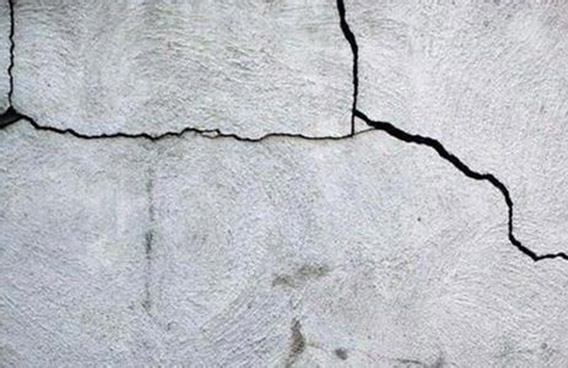Roads, floors, slabs, walls, asphalt pavements, bridges, etc. where concrete is used, there will be problems with concrete cracks. The causes are not only objective factors such as the external environment, but also subjective factors such as construction techniques and improper process operations. The following we will introduce the causes and repair methods of 7 common concrete cracks.

Causes of concrete cracks
1. cracks caused by external load
This is the most common occurrence, which is caused by the main stress calculated by conventional methods. The cracks generated by concrete members under normal static, dynamic and secondary stresses are called load cracks. In summary, there are mainly direct stress cracks and secondary stress cracks.
2. cracks caused by temperature changes
Temperature change is the main cause of concrete cracks. Concrete has thermal expansion and contraction properties. When the external environment or the internal temperature of the structure changes, the concrete will be deformed, especially large-volume concrete. Under the combined effect of external ambient temperature and internal water heating effect, concrete is very prone to have cracking problems.
3. cracks caused by uneven settlement of the foundation
If the foundation of the project is poor foundation of soft soil, the foundation strength and bearing capacity are poor, and uneven settlement occurs on the foundation. The concrete of the superstructure may have crack problems. When subjected to natural disasters such as heavy rainfall and earthquake, the foundation will also appear uneven settlement to cause cracks in the concrete part.
4. the design reasons
1) Cracks in the components resulting from stress concentration caused by sudden changes in the section in the design structure. 2) Improper prestressing of the components in the design, resulting in cracks in the components (eccentricity, excessive stress, etc.). 3) In the design, the structural reinforcement is too small or too thick, causing cracks in the components (such as wall panels, floors). 4) The shrinkage deformation of concrete members is not fully considered in the design. 5) The grade of concrete used in the design is too high, resulting in excessive ash content, which is unfavorable for shrinkage.
5. cracks caused by shrinkage
In actual engineering, cracks caused by shrinkage of concrete are the most common. Among the shrinkage types of concrete, plastic shrinkage and dry shrinkage are the main causes of volumetric deformation of concrete, as well as autogenous shrinkage and carbonization shrinkage. The main reason for the occurrence of such cracks is that the concrete is not effectively cured after hardening, such as moisturizing, heat preservation and maintenance measures are not enough. The concrete surface is exposed to the sun, causing the surface moisture loss to be too fast, and there is a large shrinkage.
6. cracks caused by freezing
When the atmospheric temperature is below zero, the water-saturated concrete freezes. The free water turns into ice, and the volume expands by 9%, so the concrete produces expansion stress. At the same time, the supercooled water in the concrete gel pores migrates and redistributes in the microstructure. The osmotic pressure increases the expansion force in the concrete, reduces the strength of the concrete, and causes cracks. In particular, the concrete is most severely frozen when it is initially set, and the concrete strength loss after ageing can reach 30% to 50%.
7. concrete cracks caused by construction and on-site maintenance
Cast-in-place concrete, if it is vibrated or improperly inserted, such as over-vibration, leakage or too fast withdrawal of the vibrating bar, will have an impact on the compactness and uniformity of the concrete, resulting in cracks. In the process of pouring large-volume concrete, if the on-site concrete cooling and insulation work is not enough and the hydration heat calculation is not accurate, the internal temperature of the concrete is too high or the temperature difference between the inside and the outside is too large, causing temperature cracks in the concrete.
How to deal with concrete cracks? What are the repair methods and repair materials?
1. surface repair method
The simple and common repair method should be the surface repair method, which is suitable for the treatment of surface cracks that have no influence on the bearing capacity, and also for the treatment of large-area fine cracks for seepage prevention and leakage prevention. It is usually possible to apply epoxy cement, cement slurry or anti-corrosion materials such as paint and asphalt to the surface of the crack.
2, grouting method
When the concrete cracks affect the structural integrity or has certain requirements for anti-seepage, it can be repaired by grouting. The grouting method uses pressure equipment to press a certain cement material, such as epoxy resin, polyurethane, cement slurry or methacrylate into the concrete crack, and after cementing and hardening, it forms a whole with the concrete to achieve the effects of sealing and reinforcing.
3. structural reinforcement method
For some penetrating and deep concrete cracks, structural reinforcement can be used for treatment, which can effectively cure the cracking problem. The following methods are commonly used in structural reinforcement: 1 increasing the cross-sectional area of the concrete structure, and wrap the steel at the corners of the members; 2 use prestressed reinforcement method; 3 reinforcing steel plate reinforcement, additional fulcrum reinforcement and shotcrete reinforcement . 4 pasting carbon fiber reinforcement method.
Cracks in concrete are not terrible, and the choice of reinforcement is an important factor in solving concrete cracks. Concrete cracking can be said to be "frequent onset" and "probable disease", often plaguing engineers. If you are also troubled by the same problem, you can contact the Nanjing Mankate Technical Consultant to discuss.
This article links to https://www.njmkt.net/Mobile/MArticles/hntlfcsd7d.html
(Editor: Nanjing Mankate, if you need to reprint, please indicate the source)